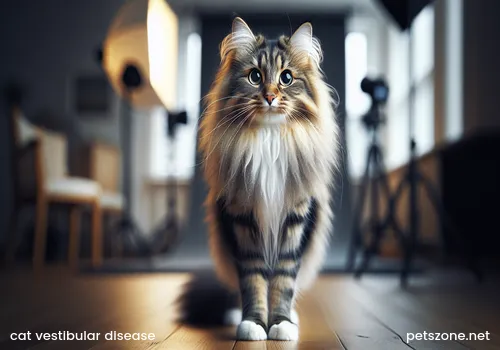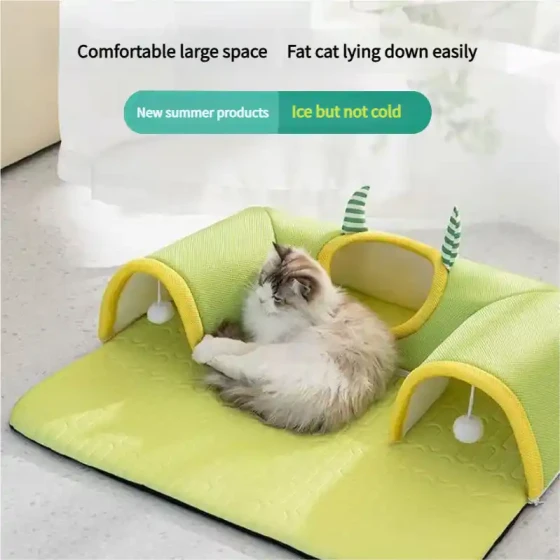Cat walks unstably with tilted head_Watch out for 5 signs of sudden vestibular disease in cats
When a cat suddenly walks unstably and tilts its head, it’s not “being cute” or acting out a scene; it’s a distress signal from its body! These symptoms likely indicate a disease affecting the cat’s balance system—vestibular disease, especially sudden vestibular disease. Understanding these signs and seeking timely medical care is vital for the cat’s health.
The vestibular system may sound unfamiliar, but it’s the “navigation system” that helps cats maintain balance and determine their orientation in space. You can think of it as a sophisticated internal gyroscope mainly composed of the inner ear and relevant parts of the brain. When this system malfunctions, cats feel dizzy, can’t stand steadily, and even basic walking and jumping become difficult.

Symptoms of sudden vestibular disease usually come on very abruptly; one moment a cat might be lively and active, and the next it can’t stand steadily. For a cat, this is like humans suddenly experiencing severe vertigo—very uncomfortable and even panic-inducing.
5 Signs to Watch for Sudden Vestibular Disease in Cats
Though the symptoms of vestibular disease vary, several key signs require special attention from cat owners:
- Unstable walking or loss of balance: This is the most direct sign of vestibular system dysfunction. Cats may stagger, sway awkwardly, or even fall down. They might walk like a “drunkard” or hesitate to jump to places they usually reach easily. In severe cases, the cat might be completely unable to stand.
- Head tilt: Tilting the head to one side is a typical symptom of vestibular disease. The cat’s head will unnaturally lean to the left or right, as if one ear is lower than the other. This tilt results from vestibular system damage, with the cat attempting to adjust head posture to regain balance.
- Eye nystagmus: Careful observation may reveal involuntary, rhythmic rapid eye movements called nystagmus. The eyes might tremble horizontally, vertically, or rotationally. This symptom is also due to the close relationship between the vestibular system and eye movement.
- Circling or rolling: Some cats exhibit continuous circling in one direction or repeatedly roll to one side. This behavior results from a loss of directional sense, feeling as if they are spinning continuously.
- Nausea, vomiting, and loss of appetite: Severe vertigo can cause car-sickness-like symptoms such as nausea, vomiting, and reduced appetite. If a normally food-loving cat suddenly loses interest in food accompanied by vomiting, it demands urgent attention.
Beyond these five common signs, some cats may also show depression, increased sleepiness, exaggerated gait, or even drooling.
Behind Vestibular Disease: Various Possible Causes
Although sudden vestibular disease (also called idiopathic vestibular syndrome) is not uncommon in cats and is often without a clear cause, it should not be taken lightly. Many potential factors can cause vestibular symptoms in cats, including:
- Inner or middle ear infection: This is a common cause of vestibular symptoms, with inflammation affecting the vestibular system’s function.
- Tumors or polyps: Tumors or polyps in the ear canal, brain, or near the vestibular system may compress nerves, causing symptoms.
- Trauma: Head or ear injuries might also damage the vestibular system.
- Inflammatory or infectious diseases: Certain inflammations or infections, such as encephalitis, feline infectious peritonitis (FIP), toxoplasmosis, may affect the vestibular system.
- Stroke: Cerebral vascular issues can lead to vestibular symptoms.
- Medications or toxins: Some drugs or exposure to toxic substances may provoke vestibular symptoms.
- Congenital abnormalities: A few cats may have congenital developmental problems of the vestibular system.
- Hyperthyroidism: Although rare, hyperthyroidism may be associated with vestibular symptoms.
- Nutritional deficiencies: Lack of nutrients such as vitamin B1 may cause nervous system abnormalities, thus affecting balance.
It is important to emphasize that although idiopathic vestibular disease generally has a good prognosis, if vestibular symptoms appear, you must promptly take the cat to the vet. The veterinarian will perform a detailed physical and neurological examination along with possible bloodwork and imaging tests (such as X-rays, CT, or MRI) to try to determine the cause and rule out serious diseases like brain tumors or stroke. This acts like a comprehensive “physical exam” for your cat’s body to find the root problem.
Diagnosis and Treatment: Targeted Medication, Careful Nursing
Vets will develop a treatment plan based on the cat’s symptoms, history, and test results. If the cause of vestibular symptoms is found, such as an ear infection, treatment mainly targets that cause, typically using antibiotics.
If other causes are excluded and it is idiopathic vestibular disease, there’s generally no specific “miracle drug”; treatment is mainly supportive care. This includes:
- Relieving discomfort: The vet may prescribe anti-nausea or anti-vertigo medications to help reduce the cat’s feelings of nausea and dizziness, making it more comfortable.
- Providing a safe environment: During recovery, providing a safe, comfortable, and quiet environment is very important. Ideally, confine the cat to a low-risk area, such as a cozy space on the floor, away from stairs and heights. Make sure that food, water, and litter box are within easy reach, and assist with feeding or elimination if necessary.
- Maintaining hydration and nutrition: If the cat cannot eat or drink normally due to nausea and vomiting, fluid therapy may be required to replenish hydration and nutrients.
- Waiting and observing: For idiopathic vestibular disease, many cats gradually improve over days to weeks, with most symptoms resolving. Like humans recovering from a cold, the cat’s vestibular system needs time to “recalibrate.”
The Road to Recovery: Patient Company and Active Rehabilitation
Recovery from vestibular disease usually takes several weeks. During this time, you may see the cat’s symptoms slowly subside, its gait steadily improve, and the head tilt lessen. Even after full recovery, some cats may retain a slight head tilt as a “reminder,” but this usually does not affect their normal life and activities.
As a cat owner, the most needed qualities during this period are patience and attentive care. Encouraging gentle activities like walking in a safe area can help the cat regain balance. Maintaining a positive attitude is also important, as your emotions affect your cat.
Common Questions and Answers
- Does vestibular disease cause pain in cats? Vestibular disease itself usually does not cause pain, but cats may feel very uncomfortable and anxious due to severe vertigo, nausea, and loss of balance.
- Will vestibular disease in cats heal on its own? Many cats with idiopathic vestibular disease do improve within weeks. However, since symptoms may be caused by more serious conditions, timely vet visits to rule out other possibilities are essential.
- How long does it take for cats to recover from vestibular disease? Symptoms of most idiopathic vestibular diseases are worst within 24-48 hours after onset, then gradually improve over several days to weeks. Most cats can recover mostly within 2-3 weeks. Some may take longer.
- Can cats’ vestibular disease relapse? Most idiopathic vestibular disease cases do not recur, but a few cats might relapse with possibly more severe symptoms. Recurrence in other causes depends on whether the underlying cause can be completely eliminated.
Conclusion
If your cat suddenly walks unstably or tilts its head abnormally, don’t panic or assume it’s just “acting out,” delaying medical attention. These may be signs of sudden vestibular disease; taking your cat to the vet for professional diagnosis and treatment promptly helps it recover health and vitality as soon as possible. As responsible pet owners, our careful observation and timely action are the most important defenses in protecting our furry children’s health.
-560x560.webp)


